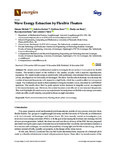Wave Energy Extraction by Flexible Floaters
| dc.contributor.author | Michele, Simone | |
| dc.contributor.author | Buriani, F | |
| dc.contributor.author | Renzi, E | |
| dc.contributor.author | van Rooij, M | |
| dc.contributor.author | Jayawardhana, B | |
| dc.contributor.author | Vakis, AI | |
| dc.date.accessioned | 2021-08-09T11:05:32Z | |
| dc.date.available | 2021-08-09T11:05:32Z | |
| dc.date.issued | 2020-11-24 | |
| dc.identifier.issn | 1996-1073 | |
| dc.identifier.issn | 1996-1073 | |
| dc.identifier.other | ARTN 6167 | |
| dc.identifier.uri | http://hdl.handle.net/10026.1/17451 | |
| dc.description.abstract |
<jats:p>We present a novel mathematical model to investigate the extraction of wave power by flexible floaters. The model is based on the method of dry modes, coupled with a matched eigenfunction expansion. Our model results compare satisfactorily with preliminary data obtained from a demonstrator device, developed at the University of Groningen. We show that the role of elasticity is to increase the number of resonant frequencies with respect to a rigid body, which has a positive effect on wave power output. The mathematical model is then extended to irregular incident waves, described by a JONSWAP spectrum. Our results show that the peak capture factors decrease in irregular waves, as compared to the monochromatic case. However, the system becomes more efficient at non-resonant frequencies. This work highlights the need to scale-up experimental investigations on flexible wave energy converters, which are still a small minority, compared to those on rigid converters.</jats:p> | |
| dc.format.extent | 6167-6167 | |
| dc.language | en | |
| dc.language.iso | en | |
| dc.publisher | MDPI | |
| dc.rights | Attribution 4.0 International | |
| dc.rights | Attribution 4.0 International | |
| dc.rights | Attribution 4.0 International | |
| dc.rights | Attribution 4.0 International | |
| dc.rights.uri | http://creativecommons.org/licenses/by/4.0/ | |
| dc.rights.uri | http://creativecommons.org/licenses/by/4.0/ | |
| dc.rights.uri | http://creativecommons.org/licenses/by/4.0/ | |
| dc.rights.uri | http://creativecommons.org/licenses/by/4.0/ | |
| dc.subject | fluid– | |
| dc.subject | structure interaction | |
| dc.subject | floating elastic plate | |
| dc.subject | wave energy | |
| dc.title | Wave Energy Extraction by Flexible Floaters | |
| dc.type | journal-article | |
| dc.type | Journal Article | |
| plymouth.author-url | https://www.webofscience.com/api/gateway?GWVersion=2&SrcApp=PARTNER_APP&SrcAuth=LinksAMR&KeyUT=WOS:000597814900001&DestLinkType=FullRecord&DestApp=ALL_WOS&UsrCustomerID=11bb513d99f797142bcfeffcc58ea008 | |
| plymouth.issue | 23 | |
| plymouth.volume | 13 | |
| plymouth.publication-status | Published online | |
| plymouth.journal | Energies | |
| dc.identifier.doi | 10.3390/en13236167 | |
| plymouth.organisational-group | /Plymouth | |
| plymouth.organisational-group | /Plymouth/Faculty of Science and Engineering | |
| plymouth.organisational-group | /Plymouth/Faculty of Science and Engineering/School of Engineering, Computing and Mathematics | |
| plymouth.organisational-group | /Plymouth/Users by role | |
| plymouth.organisational-group | /Plymouth/Users by role/Academics | |
| dcterms.dateAccepted | 2020-11-19 | |
| dc.rights.embargodate | 2021-8-10 | |
| dc.identifier.eissn | 1996-1073 | |
| dc.rights.embargoperiod | Not known | |
| rioxxterms.versionofrecord | 10.3390/en13236167 | |
| rioxxterms.licenseref.uri | http://creativecommons.org/licenses/by/4.0/ | |
| rioxxterms.licenseref.startdate | 2020-11-24 | |
| rioxxterms.type | Journal Article/Review |



